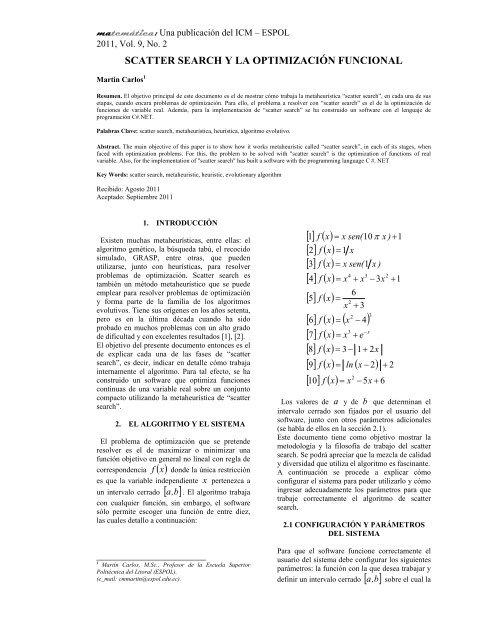matemática - Blog de ESPOL - Escuela Superior Politécnica del Litoral
matemática - Blog de ESPOL - Escuela Superior Politécnica del Litoral
matemática - Blog de ESPOL - Escuela Superior Politécnica del Litoral
Create successful ePaper yourself
Turn your PDF publications into a flip-book with our unique Google optimized e-Paper software.
<strong>matemática</strong>: Una publicación <strong>de</strong>l ICM – <strong>ESPOL</strong><br />
2011, Vol. 9, No. 2<br />
Martín Carlos 1<br />
SCATTER SEARCH Y LA OPTIMIZACIÓN FUNCIONAL<br />
Resumen. El objetivo principal <strong>de</strong> este documento es el <strong>de</strong> mostrar cómo trabaja la metaheurística “scatter search”, en cada una <strong>de</strong> sus<br />
etapas, cuando encara problemas <strong>de</strong> optimización. Para ello, el problema a resolver con “scatter search” es el <strong>de</strong> la optimización <strong>de</strong><br />
funciones <strong>de</strong> variable real. A<strong>de</strong>más, para la implementación <strong>de</strong> “scatter search” se ha construido un software con el lenguaje <strong>de</strong><br />
programación C#.NET.<br />
Palabras Clave: scatter search, metaheurística, heurística, algoritmo evolutivo.<br />
Abstract. The main objective of this paper is to show how it works metaheuristic called “scatter search”, in each of its stages, when<br />
faced with optimization problems. For this, the problem to be solved with "scatter search" is the optimization of functions of real<br />
variable. Also, for the implementation of "scatter search" has built a software with the programming language C #. NET<br />
Key Words: scatter search, metaheuristic, heuristic, evolutionary algorithm<br />
Recibido: Agosto 2011<br />
Aceptado: Septiembre 2011<br />
1. INTRODUCCIÓN<br />
Existen muchas metaheurísticas, entre ellas: el<br />
algoritmo genético, la búsqueda tabú, el recocido<br />
simulado, GRASP, entre otras, que pue<strong>de</strong>n<br />
utilizarse, junto con heurísticas, para resolver<br />
problemas <strong>de</strong> optimización. Scatter search es<br />
también un método metaheurístico que se pue<strong>de</strong><br />
emplear para resolver problemas <strong>de</strong> optimización<br />
y forma parte <strong>de</strong> la familia <strong>de</strong> los algoritmos<br />
evolutivos. Tiene sus orígenes en los años setenta,<br />
pero es en la última década cuando ha sido<br />
probado en muchos problemas con un alto grado<br />
<strong>de</strong> dificultad y con excelentes resultados [1], [2].<br />
El objetivo <strong>de</strong>l presente documento entonces es el<br />
<strong>de</strong> explicar cada una <strong>de</strong> las fases <strong>de</strong> “scatter<br />
search”, es <strong>de</strong>cir, indicar en <strong>de</strong>talle cómo trabaja<br />
internamente el algoritmo. Para tal efecto, se ha<br />
construido un software que optimiza funciones<br />
continuas <strong>de</strong> una variable real sobre un conjunto<br />
compacto utilizando la metaheurística <strong>de</strong> “scatter<br />
search”.<br />
2. EL ALGORITMO Y EL SISTEMA<br />
El problema <strong>de</strong> optimización que se preten<strong>de</strong><br />
resolver es el <strong>de</strong> maximizar o minimizar una<br />
función objetivo en general no lineal con regla <strong>de</strong><br />
correspon<strong>de</strong>ncia f ( x)<br />
don<strong>de</strong> la única restricción<br />
es que la variable in<strong>de</strong>pendiente x pertenezca a<br />
un intervalo cerrado [ a , b]<br />
. El algoritmo trabaja<br />
con cualquier función, sin embargo, el software<br />
sólo permite escoger una función <strong>de</strong> entre diez,<br />
las cuales <strong>de</strong>tallo a continuación:<br />
________________________<br />
1 Martín Carlos, M.Sc., Profesor <strong>de</strong> la <strong>Escuela</strong> <strong>Superior</strong><br />
<strong>Politécnica</strong> <strong>de</strong>l <strong>Litoral</strong> (<strong>ESPOL</strong>).<br />
(e_mail: cmmartin@espol.edu.ec).<br />
[ 1]<br />
f ( x)<br />
[] 2 f ( x)<br />
[] 3 f ( x)<br />
[] 4 f ( x)<br />
[] 5 f ( x)<br />
=<br />
= 1 x<br />
=<br />
x sen(<br />
= x<br />
6<br />
= 2<br />
x + 3<br />
1<br />
2<br />
[] 6 f ( x)<br />
= ( x − 4)<br />
x sen(<br />
10π<br />
x ) + 1<br />
− 3x<br />
3 −x<br />
[] 7 f ( x)<br />
= x + e<br />
[] 8 f ( x)<br />
= 3 − 1 + 2x<br />
[] 9 f ( x)<br />
= ln ( x − 2)<br />
2<br />
[ 10]<br />
f ( x)<br />
= x − 5x<br />
+ 6<br />
4<br />
+ x<br />
3<br />
3<br />
x )<br />
2<br />
+ 2<br />
+ 1<br />
Los valores <strong>de</strong> a y <strong>de</strong> b que <strong>de</strong>terminan el<br />
intervalo cerrado son fijados por el usuario <strong>de</strong>l<br />
software, junto con otros parámetros adicionales<br />
(se habla <strong>de</strong> ellos en la sección 2.1).<br />
Este documento tiene como objetivo mostrar la<br />
metodología y la filosofía <strong>de</strong> trabajo <strong>de</strong>l scatter<br />
search. Se podrá apreciar que la mezcla <strong>de</strong> calidad<br />
y diversidad que utiliza el algoritmo es fascinante.<br />
A continuación se proce<strong>de</strong> a explicar cómo<br />
configurar el sistema para po<strong>de</strong>r utilizarlo y cómo<br />
ingresar a<strong>de</strong>cuadamente los parámetros para que<br />
trabaje correctamente el algoritmo <strong>de</strong> scatter<br />
search.<br />
2.1 CONFIGURACIÓN Y PARÁMETROS<br />
DEL SISTEMA<br />
Para que el software funcione correctamente el<br />
usuario <strong>de</strong>l sistema <strong>de</strong>be configurar los siguientes<br />
parámetros: la función con la que <strong>de</strong>sea trabajar y<br />
a , b sobre el cual la<br />
<strong>de</strong>finir un intervalo cerrado [ ]

















